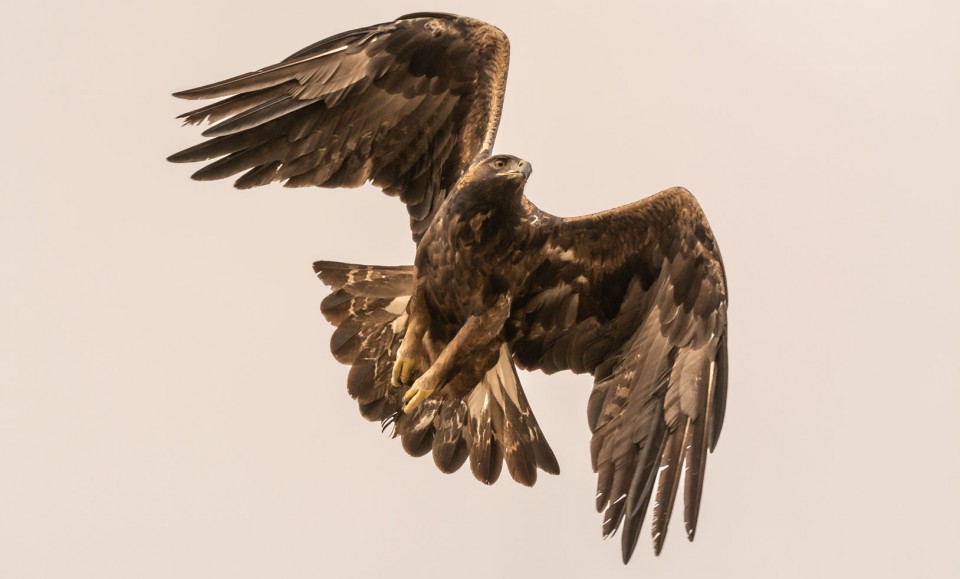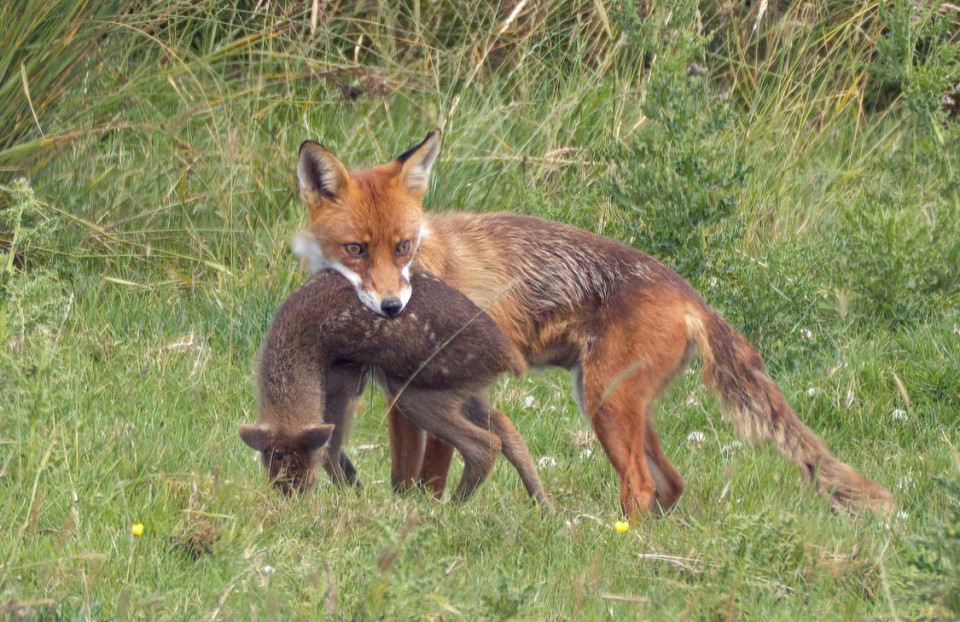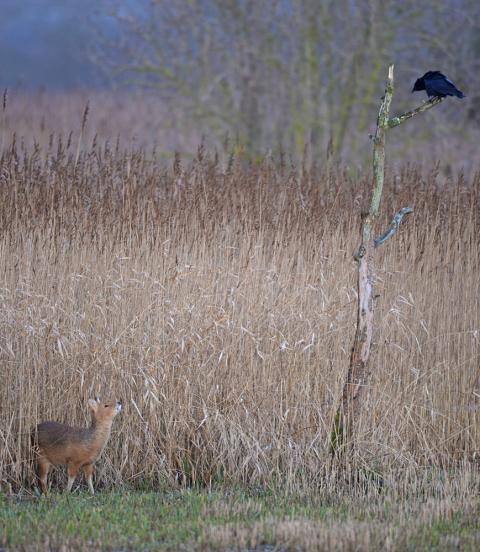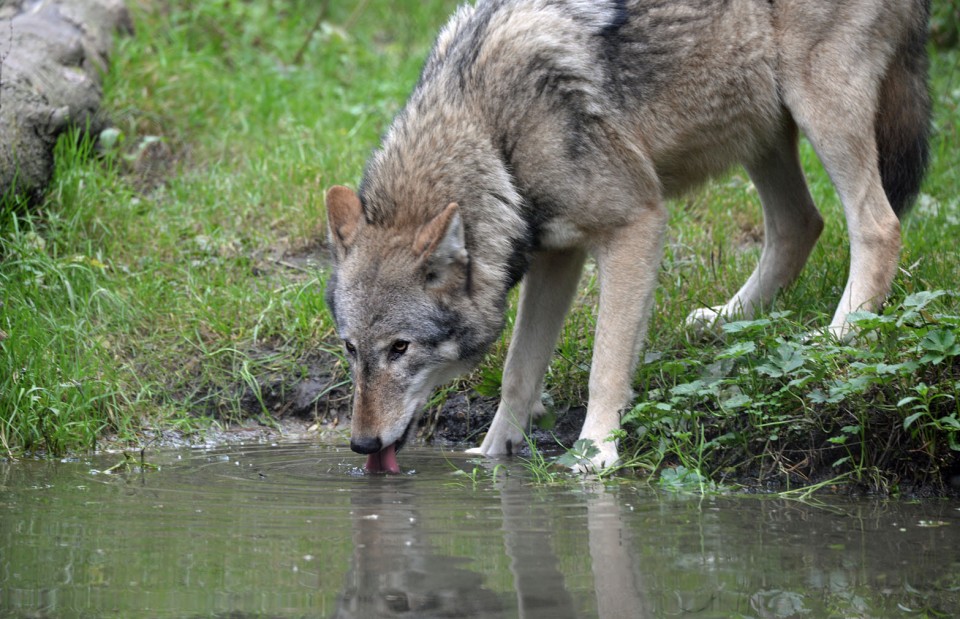Water Deer Mortality - Predators
As we've seen, survival rates for both young and adult water deer fluctuate markedly across years; susceptible to predation, the elements and being seemingly rather accident-prone. Indeed, Arnold Cooke once commented to me that "CWD have found many different ways of dying ...". In the following sections, we'll look at some of the main sources of mortality, although this should not be considered a complete list.
For ease of treatment, I've divided the causes into "predator" and "non-predator" categories, but it's important to recognise that they are not mutually exclusive, and one can make an individual susceptible to the other. Malnutrition caused by an injury or protracted bad weather can make a deer more vulnerable to a predator, for example. Similarly, a heavy parasite burden can cause an animal to succumb to weather conditions that a healthy individual may endure.
Although a potentially significant source of mortality, hunting by humans and parasites and diseases are discussed separately.
Predators
Being a relatively small species, water deer are vulnerable to a variety of predators, particularly as fawns. It's important to recognise, however, that predation events are very seldom witnessed. This makes it difficult to know how many of the species known to include water deer in their diets are capable of catching and killing one, and which just take advantage of a fortuitous carcass. Regardless, several species of mammals and birds are known to feed on water deer, particularly upon fawns, and in their 2009 book Wild Deer in Britain, Roy Harris and Ken Duff suggest the species 'suffers crippling losses to predators'.

The British countryside is devoid of large predators, and I doubt any of the remaining carnivores are capable of catching and bringing down a healthy adult water deer. Probable exceptions are the golden (Aquila chrysaetos) and white-tailed (Haliaeetus albicilla) eagles, but the former is restricted to upland regions of Scotland and western Northern Ireland devoid of water deer. The latter is only starting to recolonise England following recent release programs and, at the time of writing, I know of no examples of either feeding on Hydropotes in the UK, although golden eagles are known to attack them in their native range. In 2012, for example, Korean naturalist Jumoon Yoon photographed a young (first winter) golden eagle attacking a fleeing water deer just outside Seosan city.
For adult water deer, it is likely that the only significant predator is the domestic dog, although it is unknown how many are killed each year. Kenneth Whitehead noted how water deer have been easily caught by dogs, neither fleeing nor fighting back. Writing in 1950, he described the deer "as though mesmerized" by the dog. Paul Childerley, a Bedfordshire-based deer manager, has observed something similar, commenting on how bucks refuse to leave their rutting stands during the early winter, making them very susceptible to being caught by the dogs of illegal deer coursers. Norfolk/Suffolk Hunt Saboteurs reported that the hounds belonging to the Easton Harriers attacked and injured a Chinese water deer while hunting hares in October 2018, but it's unknown how often such incidents occur in England. Outside of Britain, in a 2002 paper to Acta Zoologica Sinica, Lixing Sun noted that an estimated 5-10% of adult water deer (and many more fawns) were killed by domestic dogs in China each year.

Based on studies on the captive deer at Whipsnade, red foxes (Vulpes vulpes) are probably the most significant mammalian predator of water deer fawns. Indeed, Endi Zhang calculated that foxes killed nearly 90% of fawns born at Whipsnade during his study in the early 1990s, prompting the zoo to reinforce some of the enclosures to prevent foxes getting in. Arnold Cooke tells me that he has received reports of foxes carrying dead water deer fawns at Woodwalton Fen in Cambridgeshire, and I captured a vixen carrying a dead fawn back to her cubs on a trailcam in Buckinghamshire during the summer of 2021. We know from the studies of Anders Jarnemo and colleagues in Sweden, and John Linnell and Reidar Andersen in Norway, that foxes can have a significant impact on roe deer (Capreolus capreolus). Their data suggest foxes may even switch from hunting small mammals to kids at the start of the fawning season, and there may be a similar dynamic with water deer, although data are lacking. Certainly, suppression of foxes (and corvids, see below) has corresponded with booming water deer populations on some game estates, although water deer seem to do well even in the absence of intensive fox control provided suitable cover is available.
Badgers (Meles meles) represent a threat to fawns and, writing about observations made during his own study of water deer at Whipsnade in Mammal News in 1998, Richard Champion noted that badgers (and foxes) predated deer, including adults, although he suspected "these were probably already unhealthy to some degree". Stoats (Mustela erminea) and weasels (M. nivalis) have been proposed as potential predators of fawns, although I know of no confirmed cases. Similarly, in his Wild Life in China, Or, Chats on Chinese Birds and Beasts, published in 1911, George Lanning wrote that the wild cat (Felis silvestris) "is alert enough to spring on a rising pheasant, he sometimes has weight enough to secure a fawn, possibly even, with assistance, the smaller adult local deer, Hydropotes inermis." If any pure-bred wild cats remain in Britain, they're invariably restricted to the Highlands of Scotland and therefore highly unlikely to encounter water deer. Increasingly widely distributed in England, wild boar (Sus scrofa) may also become a predator of water deer fawns at some point, given they're known to take roe deer (Capreolus capreolus) kids in Europe and North Korea. Data are lacking, but domestic dogs may also take their toll on fawns and possibly even adult deer. The 2012 Norfolk Bird and Mammal Report carried mention of a juvenile buck killed by a dog near Holkham, for example, while a project to release water deer into Laogang and Nanhui in China during 2020 and 2021 was hampered by significant disturbance and predation caused by packs of feral domestic dogs on both sites.
Among the avian predators in Britain, corvids, particularly carrion crows (Corvus corone) and magpies (Pica pica), appear to be the most significant where there is little cover in which fawns can hide. Endi Zhang observed attacks by corvids during his study and, in his 1998 Mammal News article, Richard Champion recounted how fawns "... were mobbed by two or more crows, jackdaws etc. and literally pecked to death". Similarly, in a 2016 film for the Field Sports Channel, Paul Childerley described having seen crows "follow the female Chinese water deer around to actually see where she's going to have the fawns, for the afterbirth" but also commented that the crows will peck a fawn's eyes out. Childerley suggested that several older animals they've shot with a missing eye were survivors of a corvid attack as fawns. There are reports from northern England and Scotland of ravens (Corvus corax) attacking ewes in labour and pulling out their unborn lambs, which implies they have the potential to be predators of water deer, too.
More recently, during the Covid-19 lockdown of June 2020, the keepers at Whipsnade Zoo did a sweep of the park and collected eight fawns for hand rearing in a protected enclosure. One of the animal care staff involved in the project told me that hardly any fawns had survived the previous couple of years, owing largely to corvid predation. They explained how "The corvids being as smart as they are, over the years learned when a female was in labour and would wait nearby and attack pretty much as soon as it was born. They also picked off and killed ones which were even a few days old." A few fawns were found to have been attacked before the keepers reached them, but all the hand-reared fawns did well - some bred during the subsequent winter and successfully reared their fawns. The process was repeated in June of 2021, with ten fawns recovered and reared by the keepers and again in 2022 and 2023, with only female fawns collected.

The availability of cover appears to be a critical factor in limiting corvid predation. In his 2019 Muntjac and Water Deer, Arnold Cooke recounted a conversation with Callum Thomson, former deer manager at Woburn, in which he recalled how fawns were often lost to corvids and gulls within the park, while growing crops on some of the surrounding farmland protected them by providing cover. Similarly, Robert Lawrence didn't record any predation events among the water deer in his enclosed woodland at West Midlands Safari Park during the 1980s, despite "a heavy local population of rooks, crows, jackdaws and magpies", and a keeper involved in the Whipsnade fawn collection project noted how all the fawns produced by the 2020 hand reared animals survived because the enclosure they were put in had so much cover that even the staff had difficulty seeing the young.
I have come across mention on Internet forums that red kites (Milvus milvus) and buzzards (Buteo buteo) will take very young fawns, but I know of no confirmed cases of this and the keepers at Whipsnade have not encountered the issue, despite a significant kite population. Similarly, in Buckinghamshire, Sharon Scott has observed water deer and kites breeding in the same area across multiple years without any apparent predation. Norfolk Mammal Recorder Dave Leech reported that two marsh harriers (Circus aeruginosus) were observed feeding on the carcass of a water deer at Potter Heigham, on the Norfolk Broads, in 2009. There are no further details in the report, but while they are potentially predators of young fawns, in this case it seems likely they were exploiting an already-dead animal. Nonetheless, marsh harriers are sometimes observed chasing water deer. In April 2024, for example, Steve Ball photographed an adult bird chasing a doe at Holme Fen, Cambridgeshire, one of the photos showing the bird making contact with the back of the deer's neck with its talons. Likewise, during early September 2024, Sue Bignell observed a harrier chasing what appears from the photo to be an adult buck at Cley Marshes, Norfolk. In the first example, the deer presumably strayed too close to a harrier nest, resulting in its eviction by a parent bird, but the reason for the Norfolk chase is less obvious as this occurred well outside the breeding season. Perhaps a juvenile bird having fun? In both cases, it seems unlikely the either bird posed any significant threat to the deer. There is also an intriguing mention of a water deer being chased by a barn owl (Tyto alba) at Potter Heigham in the 2005 Norfolk Bird and Mammal Report, but no mention of how the chase ended.
Lixing Sun noted how, historically, tigers (Panther tigris), leopards (P. pardus) and red dogs (Cuon alpinus) would've predated water deer in China. Today large predators have suffered significant declines in both distribution and abundance and only tigers appear to cooccur with water deer today. I know of no confirmed reports of predation of water deer by tigers, but in their assessment of South China tiger reintroduction potential to Chinese nature reserves, published in Biological Conservation during 2015, Yiyuan Qin and colleagues list water deer as potential prey, also pointing to wild boar and sika deer (Cervus nippon) being critical prey species.
In their 1984 paper to Acta Therologica Sinica, Helin Sheng and Houji Lu referenced the small population of leopard cats (Prionailurus bengalensis) on the Zhoushan islands, which may prey on water deer fawns. Additionally, yellow-throated martens (Martes flavigula) and raccoon dogs (Nyctereutes procyonoides) presently overlap in distribution with water deer and may represent a threat to fawns. As water deer expand into northern China and Russia, adults can fall prey to tigers and leopards and may be vulnerable to predation by wolves. Wolves are certainly large enough to tackle an adult water deer and David Jones, the ZSL Director of Veterinary Services in the early 1980s, reported that a number of animals, including Chinese water deer, were badly injured when six grey wolves (Canis lupus) dug their way out of Wolf Wood at Whipsnade early in February of 1980. In his Ph.D. thesis, completed in 2023, Ying Li noted that, in 2021, water deer teeth were discovered in a tiger's (Panthera tigris) scat in Russia by a local ranger and, on the last day of the same year, a camera trap on the Chinese side of the Tumen River caught a leopard (Panthera pardus) preying on a water deer.

Very few large carnivores remain on the Korean Peninsula to predate water deer, although historically amur tigers, leopards, lynx (Lynx lynx),and brown bears (Ursus arctos) would all have been potential predators. Today, grey wolves are probably the only threat to adults there, while raccoon dogs and yellow-throated marten (Martes flavigula) are probably the only remaining predators of fawns.
I would be interested to hear from readers who know of confirmed reports of water deer predation by carnivores in China or Korea.